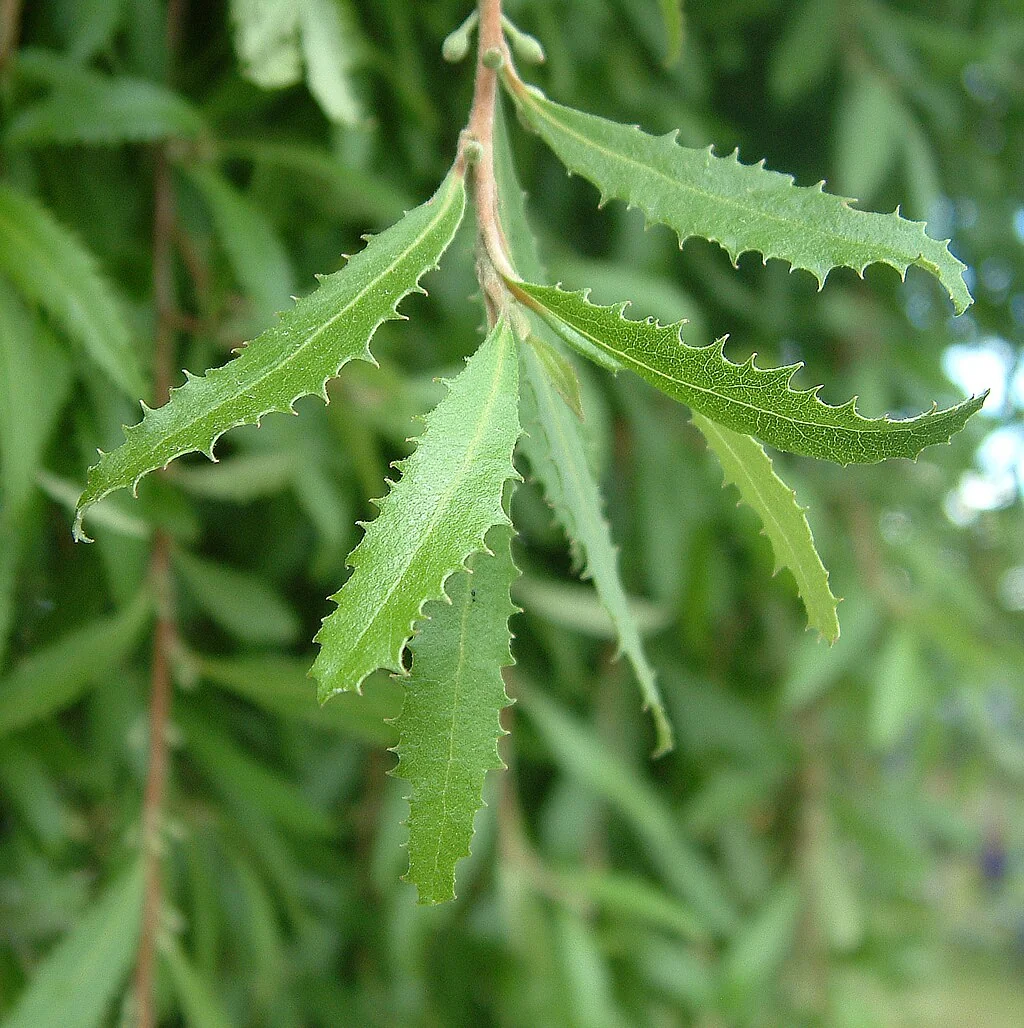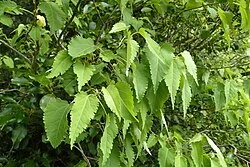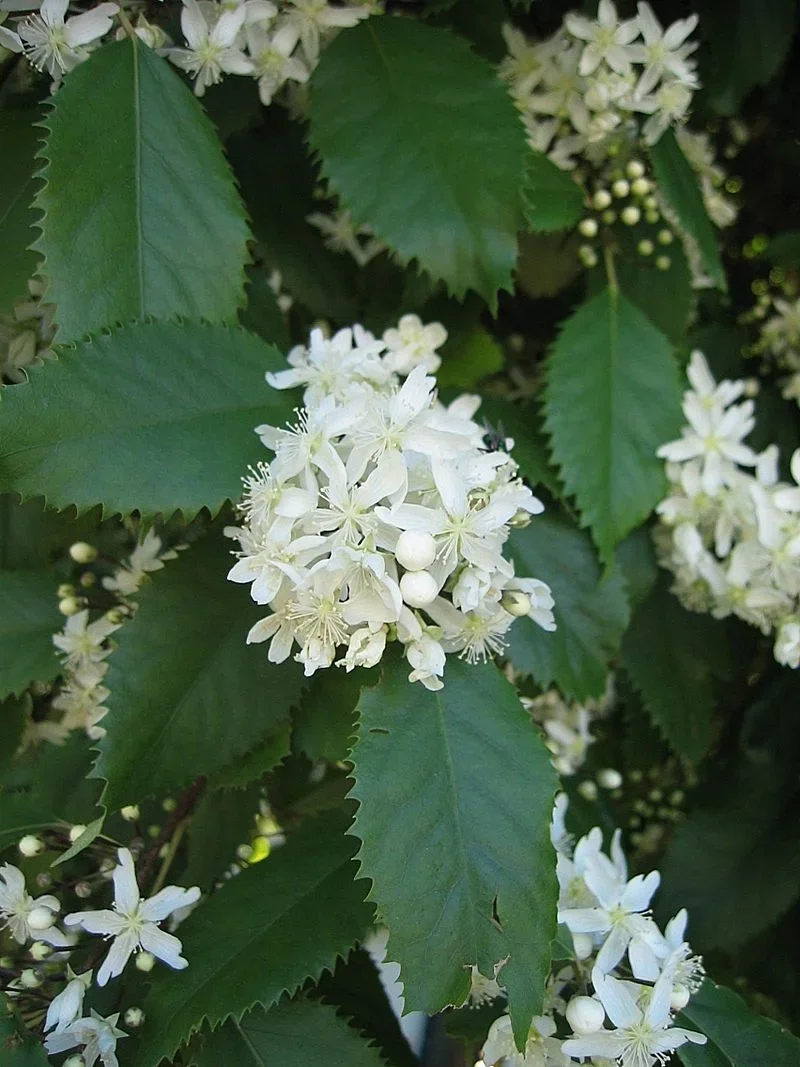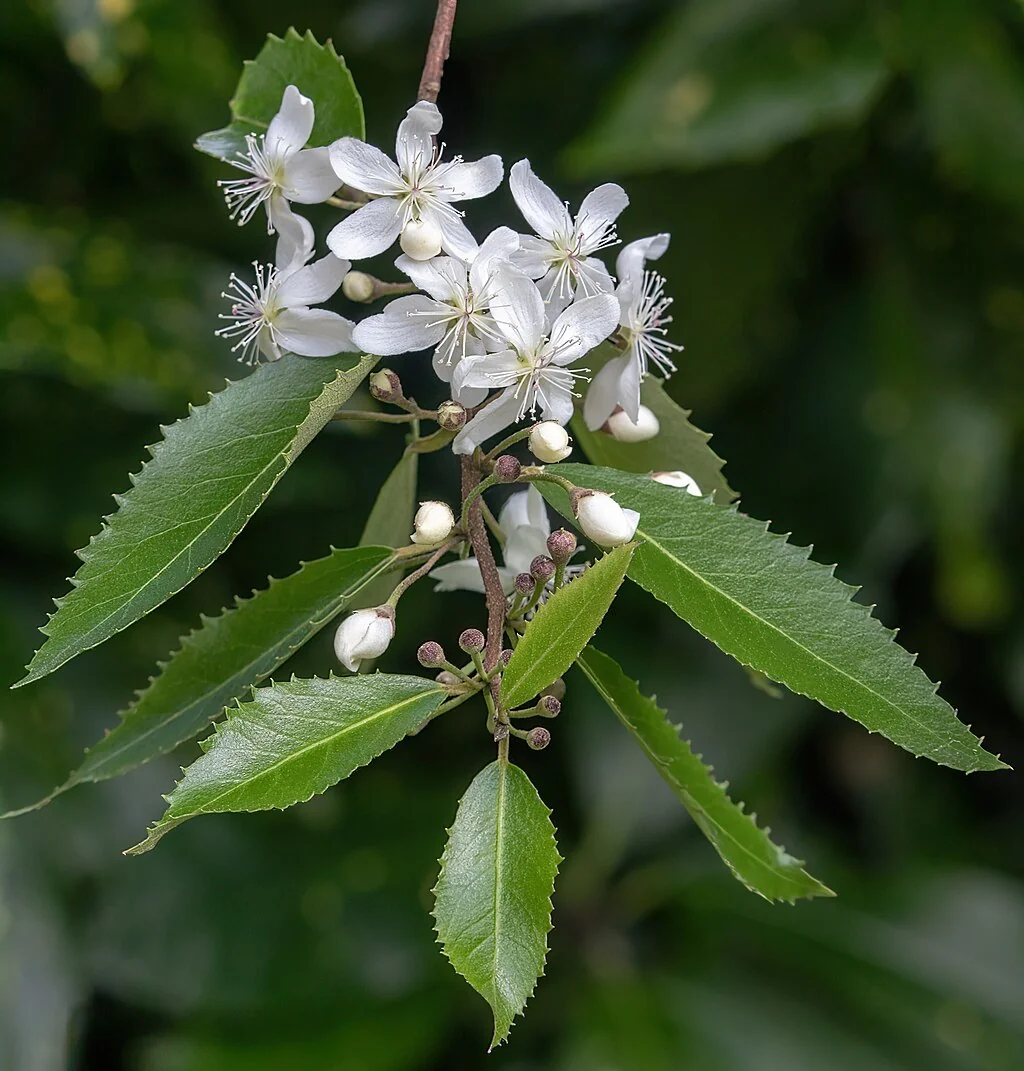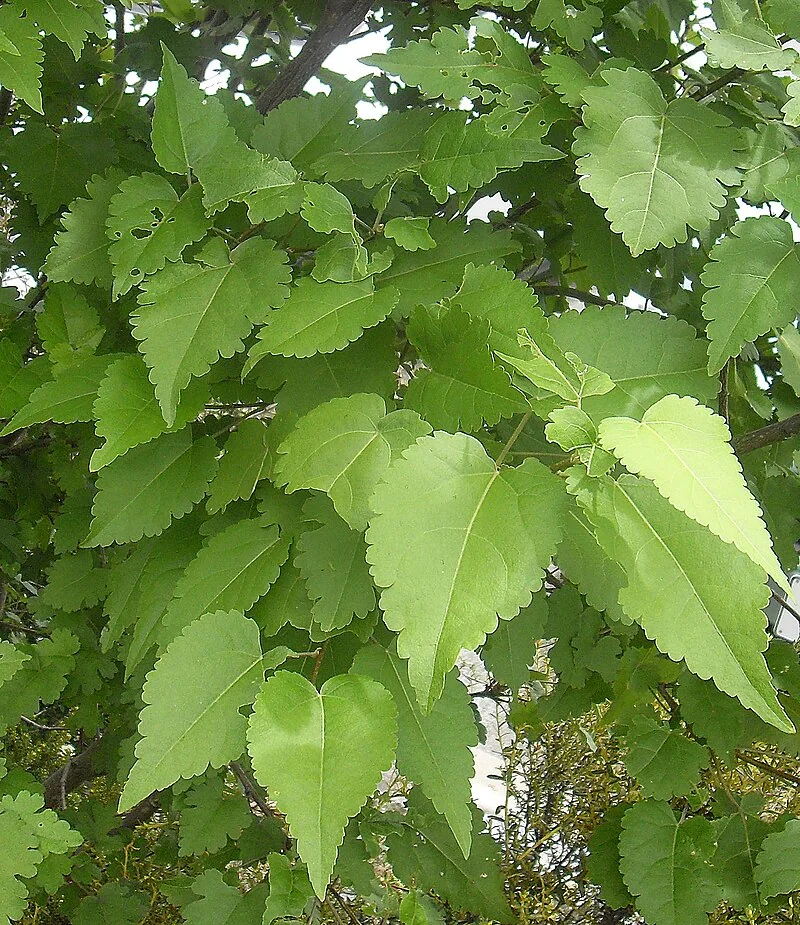
Mountain Ribbonwood
Hoheria glabrata
Mountain Ribbonwood ( Hoheria glabrata ) is a spectacular deciduous native tree renowned for its fragrant white flowers and stunning golden autumn foliage. This hardy species, known to Māori as "houhere," thrives in the wetter mountain regions of New Zealand's South Island and isolated populations on Mt Taranaki, where it forms an essential part of montane forest ecosystems. Growing 8-12 meters tall with distinctive soft-wooded branches and serrated heart-shaped leaves, this remarkable tree is unusual among New Zealand natives for its deciduous habit. The lace-like inner bark has significant cultural importance to Māori , traditionally used for fine weaving and textiles. Mountain Ribbonwood's rapid growth, tolerance of wet conditions, and exceptional ornamental value make it an outstanding choice for larger gardens and restoration projects seeking authentic New Zealand flora . Its adult leaves are elliptic to ovate, measuring 36-180 - 25-80 mm, with distinctive serrated margins and turn magnificent yellow-red tones in autumn before falling, creating spectacular seasonal displays that rival any exotic deciduous tree.

Plant Description
Hoheria glabrata (mountain ribbonwood) is a small to medium tree with smooth leaves and profuse white flowers in late summer; adapted to cooler, montane climates.
Quick Facts
| Scientific Name | Hoheria Glabrata |
|---|---|
| Common Name | Mountain Ribbonwood, Lacebark Tree |
| Plant Type | Deciduous tree |
| Height | Up to 10 m (can reach 8-12 m) |
| Spread | Up to 3 m (can reach 4-6 m) |
| Leaves | Oval, bright green, serrated edge, turn yellow-red in autumn |
| Flowers | Fragrant, white, star-shaped (summer) |
| Fruit | Dry, papery, winged fruit |
| Habitat | Wetter mountain areas of western South Island and Mt Taranaki |
| Uses | Ornamental, ecological restoration, shelterbelts, larger gardens |
| Water Needs | Moderate - prefers moist, well-drained soil |
| Light | Full sun to partial shade |
| Frost Tolerance | Very hardy - tolerates temperatures to -15°C |
| Salt Tolerance | Moderate - can handle some coastal exposure |
| Growth Rate | Fast - reaches mature size in 10-15 years |
| Lifespan | Long-lived deciduous tree (50+ years) |
Climate Best Suited to
Cool temperate and montane; hardy to frost and snow; prefers reliable moisture and shelter from hot winds.
Regional Suitability
| City | Climate Suitability |
|---|---|
| Whangārei | Ideal |
| Auckland | Ideal |
| Hamilton | Ideal |
| Tauranga | Ideal |
| Rotorua | Ideal |
| Gisborne | Ideal |
| New Plymouth | Ideal |
| Napier | Ideal |
| Whanganui | Ideal |
| Palmerston North | Ideal |
| Wellington | Ideal |
| Nelson | Ideal |
| Christchurch | Ideal |
| Dunedin | Ideal |
| Invercargill | Ideal |
Natural Habitat
Mountain Ribbonwood occupies a specialized ecological niche within the montane forest margins and river terraces of New Zealand's South Island interior, where it forms an essential component of the transition zones between lowland and subalpine ecosystems. The species naturally occurs in the wetter regions of the western South Island, particularly in areas that receive higher annual rainfall from prevailing westerly weather patterns, along with isolated populations on Mt Taranaki that represent unique genetic variations adapted to specific local conditions. These natural habitats are characterized by fertile, well-drained soils derived from alluvial deposits and weathered rock substrates, typically found in valley floors and gentle slopes where moisture accumulates without becoming waterlogged. Mountain Ribbonwood thrives in locations that experience distinct seasonal temperature variations, with cool winters that fulfill its deciduous dormancy requirements and mild summers that promote optimal growth and flowering performance. The natural distribution includes river terraces, forest clearings, and areas where natural disturbance has created openings in the forest canopy, allowing this relatively fast-growing species to establish and compete effectively with surrounding vegetation. Within these montane environments, the species contributes significantly to biodiversity by providing habitat and resources for numerous native wildlife species while helping to stabilize soil and maintain watershed integrity through its extensive root system and seasonal leaf contributions to forest floor dynamics.
Conservation Status
Current Threats and Protection
Mountain Ribbonwood ( Hoheria glabrata ) maintains a conservation status of "Not Threatened" under New Zealand's threat classification system. This stable status reflects the species' healthy population numbers and wide distribution across suitable habitats in the South Island's mountain regions, particularly in the wetter western areas and isolated populations on Mt Taranaki.
The species demonstrates good resilience within its preferred mountainous habitat, naturally occurring in forest margins and valleys where it forms part of the transition between lowland and montane forest communities. While not currently at risk, Mountain Ribbonwood benefits from ongoing habitat protection in its natural range, particularly as land use changes may affect some populations.
In cultivation, the species has proven highly adaptable and contributes to conservation through widespread use in restoration projects and private gardens. Its popularity in horticulture helps preserve genetic diversity while raising awareness of New Zealand's unique deciduous native flora. Gardeners can support conservation by choosing locally-sourced plants and allowing natural regeneration in suitable environments.
Growing Requirements
Mountain Ribbonwood is an excellent choice for New Zealand gardens, particularly in cooler, moister regions where it can showcase its spectacular seasonal displays. This hardy deciduous tree offers year-round interest with relatively straightforward cultivation requirements when provided with suitable growing conditions.
Site Selection and Growing Conditions
Choose a sunny to partially shaded location with excellent drainage and protection from strong winds during establishment. Mountain Ribbonwood thrives in moist, well-drained soils with plenty of organic matter, preferring slightly acidic to neutral pH conditions. The species performs best in cooler, moister climates and may require additional water in drier regions or during extended dry periods.
Planting and Establishment
Plant Mountain Ribbonwood in autumn or early spring when soil conditions are favorable and temperatures are moderate. Dig planting holes twice the width of the root ball and incorporate generous amounts of compost or well-rotted organic matter. Space trees at least 6-8 meters apart to accommodate their mature spread and allow for good air circulation. Water thoroughly after planting and maintain consistent moisture during the first two growing seasons.
Planting Guide
Best Planting Practices
Plant Mountain Ribbonwood in autumn or early spring when soils are workable. Dig a hole twice the width of the root ball, incorporating composted organic matter. Set the crown at finished ground level, backfill firmly, and water to settle. Space specimens 6-8 m apart to allow mature spread and airflow. Mulch 5-8 cm deep (kept clear of the trunk) to conserve moisture and moderate temperature. Stake in windy sites for the first 1-2 years and maintain even moisture through the first two growing seasons.
Ecology
Mountain Ribbonwood plays a crucial ecological role within its natural montane forest environment and provides substantial environmental benefits when cultivated in garden settings throughout New Zealand. The tree's prolific summer flowering creates an invaluable resource for native pollinators, including native bees, hover flies, and butterflies that rely on abundant nectar sources during the warmer months when many other native plants may be experiencing water stress or reduced flowering. The abundant, fragrant white flowers produce copious amounts of both nectar and pollen, supporting diverse pollinator communities that form the foundation of healthy mountain ecosystem food webs and contribute significantly to the reproductive success of surrounding plant species. Beyond its exceptional value to pollinators, Mountain Ribbonwood provides essential shelter and nesting opportunities for small native birds, lizards, and countless invertebrate species, with its branching structure offering protection from predators and harsh mountain weather conditions. The tree's deciduous nature makes a particularly important contribution to soil health and forest floor dynamics through its annual autumn leaf drop, which creates a rich organic mulch layer that gradually decomposes to release essential nutrients back into the soil system. This seasonal leaf litter also provides critical habitat for decomposer organisms, soil invertebrates, and beneficial microorganisms that maintain healthy soil structure, fertility, and water-holding capacity, ultimately supporting the entire plant community within the ecosystem while contributing to carbon storage and watershed protection.
Uses
Mountain Ribbonwood serves multiple essential functions in contemporary New Zealand horticulture, ecological restoration, and landscape design, making it an exceptionally valuable addition to both private gardens and public plantings across the country. As a feature tree for cool climate gardens, Mountain Ribbonwood provides outstanding ornamental value through its spectacular seasonal displays, including the profuse, fragrant white flowers that appear in late summer and the brilliant golden-yellow autumn foliage that creates stunning focal points in garden settings. The tree's relatively rapid growth rate and attractive natural form make it an excellent choice for establishing structural elements in larger gardens, providing canopy cover, seasonal interest, and authentic New Zealand character in landscape designs. In restoration projects, Mountain Ribbonwood plays a particularly valuable role in the rehabilitation of montane riparian strips, where its natural affinity for moist, fertile conditions and its ability to stabilize soil through extensive root systems make it ideal for erosion control and watershed protection. The species demonstrates exceptional value in ecological restoration work aimed at recreating authentic subalpine forest communities, where its role as both a pioneer species and mature canopy component makes it indispensable for establishing sustainable native ecosystems that support diverse wildlife populations. Conservation plantings benefit significantly from Mountain Ribbonwood's proven adaptability and ecological benefits, while its cultivation in gardens helps preserve genetic diversity and raises awareness of New Zealand's unique deciduous native flora among the general public.
Landscaping Ideas
Mountain Ribbonwood integrates beautifully into landscape designs that emphasize authentic New Zealand subalpine and montane character, creating stunning plant combinations that mirror the natural communities where this species naturally thrives. Combine with hardy mountain hebes such as Hebe pinguifolia, Hebe cupressoides, or Hebe armstrongii to create layered plantings that reflect the authentic plant associations found in South Island mountain environments, where these species coexist naturally and complement each other's growth habits, flowering times, and seasonal displays. Native tussock grasses, particularly Chionochloa species including Chionochloa rigida (narrow-leaved snow tussock) and Chionochloa rubra (red tussock), provide excellent textural contrast and help recreate the authentic grassland-forest margin environments where Mountain Ribbonwood naturally occurs in the wild. Pairing with native beech species such as Nothofagus solandri (mountain beech) or Nothofagus menziesii (silver beech) creates authentic montane forest plantings that showcase the natural plant communities of New Zealand's mountain regions while providing diverse habitat opportunities for native wildlife. Consider positioning Mountain Ribbonwood as a canopy specimen above lower-growing alpine plants including Celmisia species (mountain daisies), Acaena species (bidibidi), and Raoulia species (vegetable sheep), creating multi-layered plantings that provide year-round interest and demonstrate authentic ecological relationships. The tree's moderate size and elegant deciduous character also make it suitable for formal landscape designs where seasonal interest and native character are desired, particularly when combined with stone features, water elements, and architecturally significant native plants that emphasize the unique beauty of New Zealand's mountain flora.
Seasonal Care
Winter
Winter represents the optimal season for establishing Mountain Ribbonwood, as planting during dormancy minimizes transplant shock and allows the tree's energy to focus on root development rather than supporting active top growth. During winter months, plant new specimens with careful attention to soil preparation and staking requirements, ensuring the developing tree receives adequate support against wind damage while establishing its root system in the new location. This dormant period also provides the ideal opportunity for light formative pruning to establish a strong structural framework that will support the mature tree's canopy and abundant summer flowering displays. Focus pruning efforts on selecting well-spaced main branches and removing any crossing, damaged, or poorly positioned wood that could compromise the tree's natural architecture. Regularly check tree stakes and ties throughout winter to ensure they remain secure but not restrictive, adjusting as needed to prevent bark damage while maintaining adequate support against winter storms and strong winds. Winter care also includes monitoring soil drainage around newly planted trees, as excessive moisture during the dormant period can lead to root rot problems, particularly in heavy clay soils or areas with poor natural drainage. Use winter months to plan for upcoming growing season needs, including irrigation system requirements, companion plantings, and any necessary soil amendments that will support optimal growth and flowering performance in the coming year.
Pruning
Pruning Techniques
Mountain Ribbonwood responds best to minimal, careful pruning that respects its natural growth form and soft-wooded structure. Focus pruning efforts on formative shaping during the tree's first 3-5 years, establishing a strong structural framework with well-spaced main branches that will support the mature tree's canopy and abundant flowering displays. Remove any crossing, rubbing, or competing leaders early to prevent weak branch unions that could fail under wind or snow loads. Perform pruning during the dormant winter period when the tree's energy is concentrated in the root system and healing responses are most effective. The species' relatively soft wood means cuts heal quickly but are susceptible to tearing, so use sharp, clean tools to make precise cuts just above outward-facing buds or lateral branches. Avoid heavy pruning or topping, as Mountain Ribbonwood may respond with vigorous water shoot growth that compromises the tree's natural elegance and flowering performance. Dead-heading spent flowers is generally unnecessary unless seed collection is undesired, as the papery seed capsules add winter interest. Remove only dead, damaged, or diseased wood as needed, along with any suckers that develop around the base or on the main trunk.
How to Grow Mountain Ribbonwood
Seed Propagation
Fresh seed collected from ripe fruits in late summer provides an excellent propagation method for Mountain Ribbonwood. Gather papery-winged seeds as they turn brown and begin to split (March-May), remove wings, and sow immediately into a free-draining seed-raising mix for optimal germination success. The species performs best when subjected to natural cold treatment, as Mountain Ribbonwood requires winter chilling to break seed dormancy and ensure reliable flowering in cultivation. Maintain cool conditions around 15-18°C with consistent moisture levels, avoiding waterlogging which can cause seed rot. Germination typically occurs within 4-8 weeks under optimal conditions, though some seeds may take up to 12 weeks to emerge. Natural wind dispersal of the winged seeds occurs in autumn, and this timing should be replicated in cultivation for best results. Seedlings are initially slow-growing but accelerate once their root systems establish, typically showing vigorous growth in their second season when planted in suitable cool, moist conditions.
Cutting Propagation
Semi-hardwood cuttings taken in late summer to early autumn provide a reliable alternative propagation method for Mountain Ribbonwood. Select healthy, firm current-season growth and take 10-15 cm cuttings, making clean cuts just below a node to maximize rooting potential. Remove lower leaves to reduce transpiration and prevent rot, while retaining 4-6 leaves at the cutting tip. Use a well-drained propagation medium combining perlite with quality potting mix, and apply rooting hormone to encourage faster root development. Maintain humid conditions in bright, indirect light, avoiding direct sunlight that can stress developing cuttings. Bottom heat at 18-20°C significantly speeds rooting, with successful cuttings often developing strong root systems within 8-12 weeks. Once rooted, gradually acclimatize cuttings to outdoor conditions before transplanting to permanent positions in cool, sheltered locations.
Aftercare and Establishment
Whether propagated from seed or cuttings, young Mountain Ribbonwood plants require careful establishment in cool, moist conditions that replicate their natural montane habitat. Plant in well-drained soil enriched with organic matter, ensuring adequate spacing to accommodate mature size. Provide consistent moisture during establishment while avoiding waterlogged conditions, and protect from strong winds and extreme temperatures. Regular monitoring and gradual hardening off ensures successful transition to garden conditions, with established plants becoming remarkably hardy and long-lived once their root systems develop fully.
Pests and Diseases
Common Problems and Solutions
Mountain Ribbonwood demonstrates exceptional natural resistance to most common garden pests and diseases, making it a remarkably low-maintenance choice for New Zealand gardens when grown in appropriate conditions. The tree's robust health reflects its adaptation to harsh mountain environments, where natural selection has favored resistance to environmental stresses and pathogen challenges. However, gardeners should remain vigilant for occasional pest issues, particularly passionvine hopper infestations that can become problematic in warmer, more humid districts where these sap-sucking insects thrive. Passionvine hoppers feed by puncturing plant tissue to extract sap, potentially weakening the tree and creating conditions favorable for secondary problems like sooty mould development. The sticky honeydew excreted by these hoppers provides an ideal growing medium for unsightly black sooty mould fungi that can cover leaves and stems, reducing photosynthetic efficiency and compromising the tree's ornamental appeal. Encourage natural predator populations including lacewings, predatory mites, and insectivorous birds by maintaining diverse plantings and avoiding broad-spectrum insecticide applications that disrupt beneficial insect communities. Maintain good air circulation around trees through appropriate spacing and companion plantings, as improved airflow reduces humidity levels that favor both pest populations and fungal diseases. Monitor trees regularly during warm, humid weather when pest problems are most likely to develop, intervening early with targeted treatments such as horticultural oils or insecticidal soaps if necessary. Scale insects may occasionally establish on stressed or poorly sited trees, appearing as small brown bumps on stems and branches that gradually weaken the plant through continuous sap extraction.
Cultural Significance
Traditional Uses and Values
Known to Māori as "houhere," Mountain Ribbonwood holds significant cultural importance alongside its close relative Hoheria lyallii . The species' fibrous inner bark was traditionally valued by South Island Māori communities for creating fine textiles, cordage, and decorative items. This lace-like bark material was particularly prized for its strength and workability when processed correctly.
The preparation of houhere bark required specialized knowledge passed down through generations, with the inner fibrous layer carefully harvested and processed into usable textile material. Beyond practical uses, the tree's distinctive autumn coloration and fragrant flowers made it a recognizable and valued part of the forest ecosystem in traditional Māori environmental knowledge.
In contemporary New Zealand, Mountain Ribbonwood represents an important connection between traditional plant use and modern conservation. Its cultivation in gardens and restoration projects helps preserve both the species and knowledge of its cultural significance, ensuring this botanical taonga (treasure) remains part of New Zealand's living heritage for future generations.
Bonus Tip
Expert Growing Advice
Mountain Ribbonwood produces its most spectacular flowering displays when grown in locations that experience cool nighttime temperatures during the growing season, particularly in late spring and early summer when flower buds are developing. Site trees away from heat-reflecting surfaces like concrete driveways, brick walls, or metal buildings that create localized heat islands and elevate nighttime temperatures. The species' evolutionary adaptation to cool mountain environments means it responds exceptionally well to the natural diurnal temperature fluctuation found in its native habitat, where warm days and cool nights create ideal conditions for bud development and flower formation. Consider the microclimate effects of your planting location, choosing sites with good air drainage that allow cool air to settle naturally around the tree during evening hours. Trees positioned in lower areas of the garden or near water features often benefit from the cooling effect of cold air pooling and increased humidity, both of which encourage prolific flowering and healthy growth. The temperature differential between day and night also enhances the intensity of the tree's autumn coloration, with cooler nights triggering more vivid yellow and golden tones as chlorophyll breaks down in the deciduous leaves.
